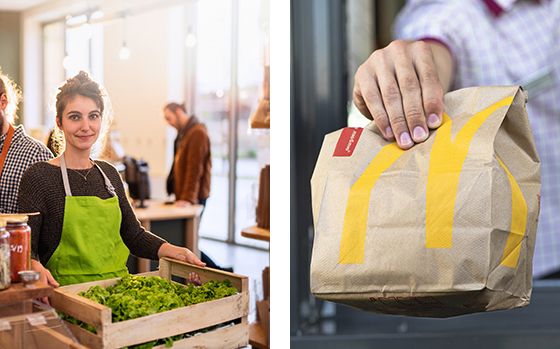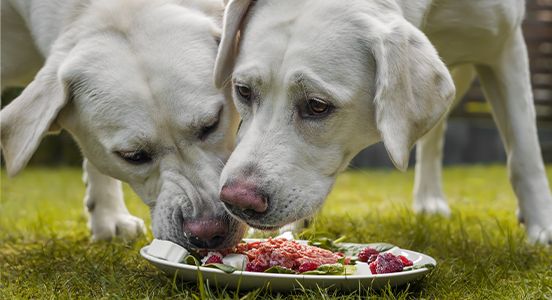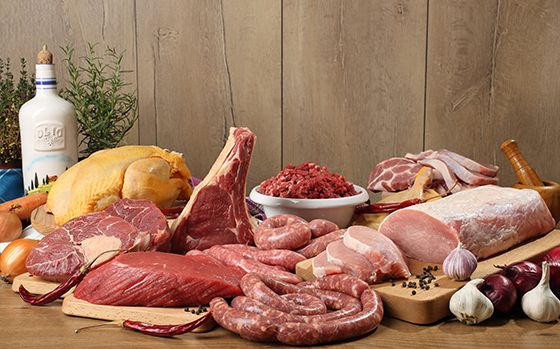On the way to species appropriate nutrition
Counting calories is a thing of the past. Today it is about culinary culture, taste and enjoyment, and species appropriate nutrition, also for children. It’s about future generations, about animals, the environment, and the whole planet. And about the prevailing industrial food system, whose harmful and unhealthy mechanisms are becoming increasingly apparent. How do we distinguish good food from bad food? What is good for our children? And a question on many people’s minds: What is best for our animals?
Good food, bad food
The war for food – and we are right in the middle of it
There is a very simple self-experiment that shows the difference: Think of a crispy chicken, a fragrant risotto with porcini mushrooms, a warm apple strudel with vanilla sauce – or sodium benzoate (E211), sodium carboxymethyl cellulose (E466), calcium orthophosphate (E341). In one case your mouth waters and in the other it doesn’t. This shows that the human body reacts very differently, depending on which of the two different spheres of nutrition it is confronted with. It also shows that the human body instinctively differentiates between these two spheres – knowing what is beneficial and what isn’t. So far, the assessment of food has been about calories, i.e. energy content, nutrients such as vitamins, minerals, contamination with pollutants, viruses, bacteria, poisons, and also elements such as sugar, salt, and fat.

Now a paradigm shift is in the offing which motivates people to ask where a food is situated between the two poles:The traditional world, where there are small farmers, gardeners, and cooks, where things like carrots, potatoes, peas and lentils, chicken, eggs, strawberries, pineapple, papaya are offered. And the industrial one, where the available goods are so-called fruit yogurt in a plastic cup, frozen pizza and cornflakes from a cardboard box, hamburgers and soft drinks.
Some researchers even speak of a "war" between these two food systems, a war about who dominates the food supply on this planet: the small farmers, gardeners, cooks, traditional home cooked meals – or the globally operating corporations such as McDonald's, Nestlé, Knorr, Coca-Cola, Red Bull.

Unfortunately, politics have clearly sided with corporations, in unison with state-funded professors from universities and research institutions, a particularly clear example being the European Food Safety Authority EFSA, but also the world government in matters of food, the Codex Alimentarius, an institution of the United Nations where corporations are included in decision making regarding global laws and regulations.
It is still unclear who will win the "war for food". Certain movements of disassociation oneself from corporate rule can be observed in science. Professors study in detail the health consequences of fast food, soft drinks, and "ultra-processed" food. Some even quit their allegiance to corporations arguing that they do not want to be on the "wrong side of history".
Medical research reveals with increasing clarity the different health consequences of industrialized and processed food, and also the benefits of real food: Doctors already consider traditional Mediterranean cuisine the "gold standard" for a health-promoting diet, while evidence is suggesting that this also applies to Chinese and Brazilian cuisine and even the Nordic cuisines of the Scandinavian countries. In conclusion of this research it can be said that a traditional diet is conducive to a long, happy, and healthy life.
The Fast Food Generation
Early Programming: How Nutrition Shapes Our Children's Destiny
A new view on nutrition: Especially important in children’s nutrition. What is the difference between a store bought and home made porridge? It may sound like a silly question but it is of fundamental importance for the fate of the little ones – and for the future of society. Today's children are confronted with industrial food like no generation has been before. This has far-reaching implications, especially for their brain, intelligence, emotions, and behavior.

And for the future of humanity on this planet. Because today’s children form tomorrow’s society, they will be the Nobel Prize winners of tomorrow, or the criminals and drug addicts of tomorrow, even the patients of tomorrow.
Many are already ill today: allergies, high blood pressure. And today’s nutrition sets the course.
For many, it begins even before birth, with the Coke that the mother drinks, the gummy bears that she treats herself with, all of which the child in the womb absorbs. And after birth, many parents will continue with industrial infant milk from bottles, or the controversial children's milk, which some authorities have wanted to ban.

And even the popular industrial baby food jars are now coming under scrutiny, among other things because they are so clean, so pure. What used to be an important advertising argument is now considered a shortcoming. The baby food jars hinder the development of the immune system, precisely because they are so sterile that they last a long time on the shelf.
In the sphere of real food, such as baby puree, homemade with fruit for example, lasts maybe two hours – in the industrial sphere, a glass must last two years. And to guarantee this, the food must be fundamentally altered. Scientists have found ten reasons to that speak against baby food from jars.
And so it continues: Fruit from the squeeze bag, BigMacs, Coke, Monster energy drinks: The fast food generation lives almost exclusively on corporate food, even at lunchtime in kindergarten, when food comes from a cooking factory. Even responsible experts favor industrial food in their relevant guidelines, some appearing as advertising figures.
A new approach to nutrition, a new concept of quality and safety – this paradigm shift is particularly vital for the lives of our children. After all they are supposed to have a better life.
Love you to Bits
Human and animal: A relationship in crisis
The domestication of animals for food is a relationship that goes back thousands of years. But now it’s in crisis. Because something has intervened. A disruptive factor. Some want to end the relationship completely – out of love and compassion for the animals. It is high time to look at this relationship with new eyes. Because it is a scandal that outrages many: our treatment of animals. On the one hand, they are our pets. Dog & cat. Beloved. Caressed & cuddled. Fed with the best food from golden bowls, elaborately advertised, praised in the most beautiful words – and in reality it is nothing but waste. Waste, from animal factories, for example. Or from food factories.

That wouldn't really be bad, after all, they have always gotten the leftovers, dogs, for example, the bone left over from the chop.
But: Now this waste has to last for a long time, be transported large distances before it reaches the factory, and later the feeding bowl.
For this, the same methods are used as in the factories for human food – it’s not surprising that pets eventually become overweight and suffer from the same diseases as their humans.
The industrialization of the food chain is a very unique challenge for animals – especially, of course, for those who are themselves a part of it, are "produced" in masses to later end up on a plate or in a bag.

Livestock. These animals are also loved to bits, quite literally. And exclusively. For millennia.
Meat was once instrumental in human evolution, the development of the brain, for example – and now, consumed en masse, it is becoming a health risk.
Even though it is still important for us today. For IQ, mood, and balanced behavior. Especially the high quality fats which, however, only occur to a significant extent if the animals are kept and fed in a species-appropriate manner.
Factory farming, on the other side, leads to meat and sausages being consumed in excess – and contributes to the spread of so-called “diseases of civilization”. Humans, and similarly, pets, are affected to their detriment by waste from animal factories, industrially processed, stretched with cheap ingredients, reinforced with chemicals: food that is "ultra-processed".
And those who then want to break free of this cycle, who full of disgust and indignation eat only animal-free products do not necessarily live healthier and often don’t escape the system.
Because many of the animal-free products in the supermarket are high-tech and crammed with industrial ingredients which then launch a major attack on our fellow creatures in the digestive tract, the so-called microbiome in the intestine. Those microorganisms that are responsible for processing food and simultaneously for our mood, even our behavior towards our fellow human beings.
It would be better to work toward living in harmony with nature. More respect for the animals. Give them a better life and better food. If the animal is happy, the human is happy.
About additives
What do they mean? How do they work? And are they unhealthy?
Why additives?
Unlike regular ingredients such as cauliflower, cream, or ham, food additives are not a traditional part of a dish or food. They serve to improve the taste or color of the food and to make it more durable. More colorful effervescence, browner sauces, non-perishable noodle soups, airier cakes, rolls with an extra portion of bun scent, creamier cream cheese with less fat, yogurts in which each piece of fruit stays in place. Our food should appear more attractive. And for as long as possible.
What do the E numbers mean?
Most approved additives in the European Union and other countries carry so-called E numbers according to the so-called INS numbers of the International Numbering System. Citric acid, for example, can also be referred to as E330 on the label in the list of ingredients. These ingredients are therefore sometimes called "e-substances". Experts also refer to them as "additives".
There are different additive groups.
The respective task of the material can be recognized by the so-called class names. They may also be indicated on the label. Many fabrics have multiple functions. Accordingly, we can encounter the same substance, for example citric acid as, in Europe, "antioxidant E330" or as "acidifier citric acid". Other class names are: dyes, preservatives, thickeners, acidity regulators, flavor enhancers, anti-caking agents, glazing agents or sweeteners.
Are they actually unhealthy?
This question is carefully studied before an additive is approved. In animal experiments, the dose that is given freely as tolerable on a daily basis is determined. A safety margin is added to this and the so-called "ADI value" is calculated. ("Acceptable Daily Intake"). All additives are considered safe up to this dose. However, this does not apply to allergy sufferers: even the smallest amounts can be dangerous for them.
It depends on the quantity.
When approving additives, typical quantity of consumption is taken into account. From this, a maximum quantity is fixed for each type of food. This should be calculated in such a way that the ADI value is not exceeded even with frequent consumption. According to a study by the EU Commission, however, the acceptable daily dose is far exceeded for many additives, especially in children, in individual cases up to 12 times.
Can we do without them?
Many industrial foods cannot do without additives. Packet soups would quickly mold, margarine would become rancid, fruit yoghurts would separate. The ready-made salad dressing would dissolve into its components herbs, vinegar, and oil. However, there is a workaround: cook yourself using fresh ingredients. Make the dressing yourself, cook soup from scratch, and in advance or for a few days, stir fruit or jam into natural. Plain yogurt. Many also stop foods by freezing them. But there are also, especially in the organic food sector, foods without E-numbers. The label provides information.